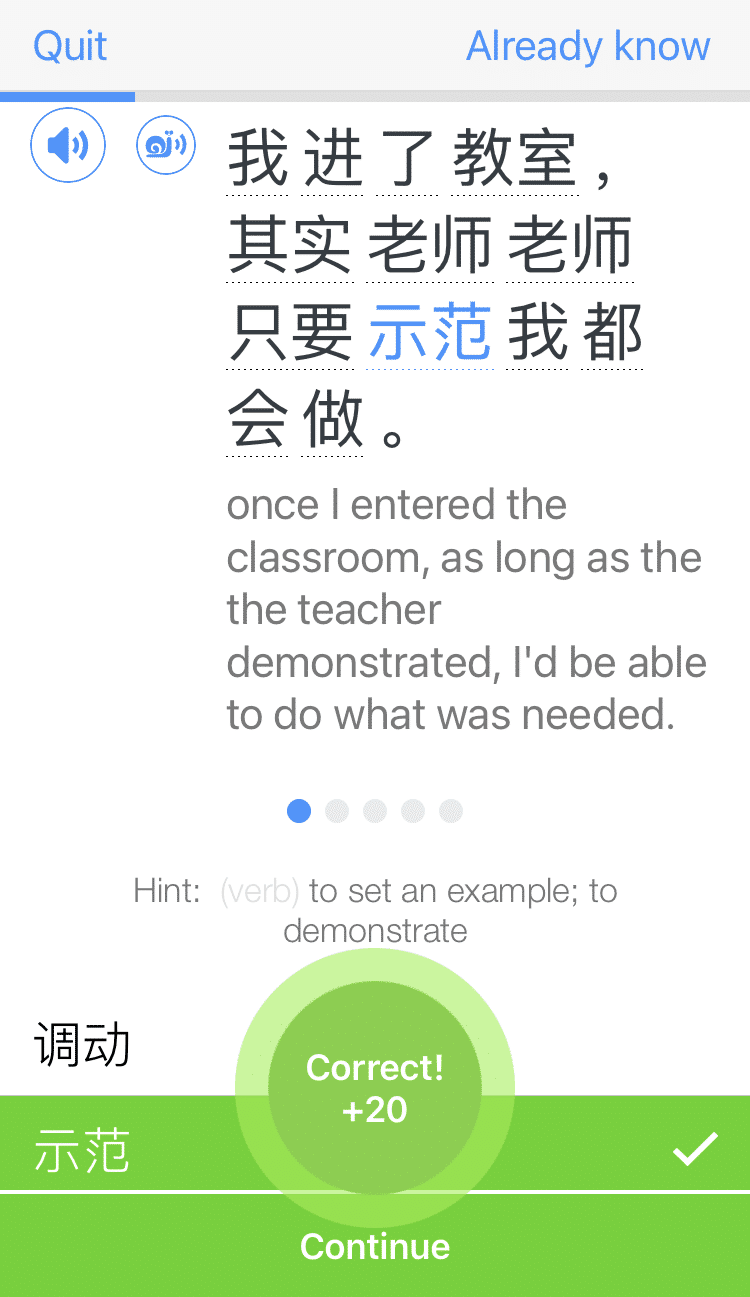
16 Ways to Say No in Chinese Like a Native Speaker
If you think 不 (bù) is how you say no in Chinese, think again.
不 is one of the first characters you learn and it’s even how the dictionary translates “no” from English.
But if you don’t want to sound like a toddler learning their first few words, you’ll need to learn the other ways to say no in Chinese—which are used much more often.
In this blog post, I’ll show you 16 words that you can use to say no in Chinese.
Contents
- Is There the Word “No” in Chinese?
- Ways to Say “No” in Chinese
-
- 1. 不是 (bú shì) — Reject Yes/No Questions
- 2. 不对 (bú duì) or 错 (cuò) — Correct False Statements
- 3. 不对 (bú duì)— Make Clarifications and Corrections
- 4. 没有 (méi yǒu) — Indicate Lack of Possession
- 5. 没有 (méi yǒu) — “I Haven’t”
- 6. 不会 (bú huì) — Express Inability
- 7. 不可以 (bù kě yǐ) or 不能 (bù néng) — Deny Requests
- 8. 不能 (bù néng) — Indicate Impossibility
- 9. 不喜欢 (bù xǐ huan) — Express Dislikes
- 10. 不要 (bú yào) — Show Disinterest
- Bonus Words for Saying No in Chinese
- And One More Thing...
Download: This blog post is available as a convenient and portable PDF that you can take anywhere. Click here to get a copy. (Download)
Is There the Word “No” in Chinese?
Chinese dictionaries need to put something down for “no,” so they end up filling in the blank with 不 or 不是. Though these are technically correct, let’s talk about why both translations aren’t sufficient.
- 不 is more closely translated to “not,” and is usually paired with a verb.
- 不是 means “to not be,” so you’re really saying, “It is/I am,” or, “It is not/I am not.”
Sometimes, 不 can manifest on its own when someone is using “no” as a Chinese interjection. And to give a negative answer to a question, you either add 不 or 没 (méi) to the verb to negate it, with the literal translation of the phrase being “not + verb.”
However, there are plenty of ways to express the concept of “no” in Chinese.
Ways to Say “No” in Chinese
Here is a quick and easy overview of the different ways you can say “no” in Chinese:
| Chinese | Pinyin | Usage |
| 不是 | bú shì | Reject yes/no questions |
| 不对 | bú duì | Correct false Statements |
| 错 | cuò | Correct false statements |
| 不对 | bú duì | Make clarifications and corrections |
| 没有 | méi yǒu | Indicate lack of possession |
| 没有 | méi yǒu | "I haven't" |
| 不会 | bú huì | Express inability |
| 不可以 | bù kě yǐ | Deny requests |
| 不能 | bù néng | Deny requests |
| 不能 | bù néng | Indicate impossibility |
| 不喜欢 | bù xǐ huan | Express dislikes |
| 不要 | bú yào | Show disinterest |
Now, I’ll explain these terms in a little more depth, with example sentences to show you how these terms are used in context.
1. 不是 (bú shì) — Reject Yes/No Questions
You just learned that 是 means “to be.” And when used in a yes/no question form, it’s asking for a description.
For example:
你是泰国人吗?
(nǐ shì tài guó rén ma?)
Are you Thai?
不是。我是菲律宾人。
(bú shì. wǒ shì fēi lǜ bīn rén.)
No (I am not). I am Filipino.
If the answer was “yes,” the speaker would’ve said 是, meaning “I am.” But because he’s not Thai, he answered negatively with 不是, meaning “I am not.”
There are times that you might be asked a question with the phrase 是不是 (shì bú shì) which means, “Isn’t it?”
For example:
是不是这样的?
(shì bú shì zhè yàng de?)
Isn’t it like this?
不是。
(bú shì.)
No (it isn’t).
2. 不对 (bú duì) or 错 (cuò) — Correct False Statements
Another reason you might say “no” is when you’re pointing out that someone is wrong.
In this case, you’d use the words that literally mean “incorrect,” “false” or “wrong”: 不对 or 错.
Example 1:
她的妈妈是在多伦多上的大学。
(tā de mā ma shì zài duō lún duō shàng de dà xué.)
Her mom went to university in Toronto.
不对。她是在温哥华上的大学。
(bú duì. tā shì zài wēn gē huá shàng de dà xué.)
No (Wrong). She went to university in Vancouver.
Example 2:
他有几个姐妹?
(tā yǒu jǐ ge jiě mèi?)
How many sisters does he have?
两个。
(liǎng ge)
Two.
错。他有四个。
(cuò. tā yǒu sì ge.)
No (Wrong). He has four.
As you can see, 不对 or 错 can be used interchangeably, but take note that 错 sounds slightly rude.
3. 不对 (bú duì)— Make Clarifications and Corrections
Chinese speakers double-check their facts with the phrase 对不对 (duì bú duì), which means “right?”
So if someone is asking for clarification, the appropriate “no” answer would be 不对.
你的约会在下午五点,对不对?
(nǐ de yuē huì zài xià wǔ wǔ diǎn, duì bú duì?)
Your appointment is at 5 p.m., right?
不对。下午四点。
(bú duì. xià wǔ sì diǎn.)
No (Wrong). 4 p.m.
Sometimes you might see 对吗 (duì ma) or 对吧 (duì ba) instead of 对不对.
Just know that they all mean “right?” and require a response of either 对 or 不对.
4. 没有 (méi yǒu) — Indicate Lack of Possession
不 is used to negate verbs except “to have,” which is 有. Instead, it’s negated by 没.
没 literally means “don’t have,” making it the way to say you don’t have something.
你有没有iPhone?
(nǐ yǒu méi yǒu iPhone?)
Do you have an iPhone?
没有。
(méi yǒu.)
No (I don’t have one).
Note: Both 有吗 (yǒu ma) and 有没有 can be used to say, “Do you have?”
5. 没有 (méi yǒu) — “I Haven’t”
Chinese doesn’t have auxiliary verbs like English, but you can use 没有 to say that you haven’t done something.
Thus, “I haven’t” would be used as your negative answer.
你吃了吗?
(nǐ chī le ma?)
Have you eaten yet?
没有。
(méi yǒu.)
No (I haven’t).
6. 不会 (bú huì) — Express Inability
We can’t possibly be good at everything, so there’s no shame in letting people know that you don’t have the skills that they’re asking for.
When expressing ability, the character you need is 会.
你会说中文吗?
(nǐ huì shuō zhōng wén ma?)
Can you speak Chinese?
不会。
(bú huì.)
No (I can’t).
It’s important to remember that 会 refers to skills that must be learned and not just any ability.
Compare this to 能 (néng), which also means “can,” but refers to inherent physical ability.
7. 不可以 (bù kě yǐ) or 不能 (bù néng) — Deny Requests
When it comes to requests and permission, you use the modal verbs 可以 and 能 for “can” and “may.”
能 has multiple definitions.
For the most part, when someone uses 能 in a question, they’re asking for permission.
If you want to deny a request or refuse to give permission, all it takes is a simple 不可以 or 不能, which are used interchangeably to mean “cannot,” “may not” or more simply: “no.”
Here are a couple of examples, although try not to be as rude as these imaginary speakers.
Example 1:
我可以去洗手间吗?
(wǒ kě yǐ qù xǐ shǒu jiān ma?)
May I go to the restroom?
不能。
(bù néng.)
No (You may not).
Example 2:
你能不能帮我?
(nǐ néng bù néng bāng wǒ?) — Can you help me?
不可以。
(bù kě yǐ.)
No (I can’t).
Tip: If you still can’t figure out when it’s appropriate to use each answer, just go with 不可以.
Some people are more comfortable using 可以 in conversations, as it’s quite common in everyday situations like traveling.
8. 不能 (bù néng) — Indicate Impossibility
Sometimes, we like to embellish and exaggerate to add a bit of a dramatic effect to our speech. So there are times when a simple “no” just won’t do.
We know that 能 can mean either “may” or “can” and is used to request permission.
However, it can also ask about possibilities, like if there’s a chance that a certain event will happen.
And if you want to say “no” to a question like, “Is it possible?” you would say 不能.
For example:
能不能推迟婚礼?
(néng bù néng tuī chí hūn lǐ ?)
Is it possible to postpone the wedding?
不能!
(bù néng!)
No (Impossible)!
Unlike most of the other examples that follow the verb / 不 + verb format for yes/no answers, 能 isn’t commonly used on its own.
You’d just answer “yes (it is possible)” with 可以.
Curious about other ways to express impossibility? Here are a couple more terms you might want to use to deny any future request:
不行 (bù xíng) — It can’t be done; no way
不可能 (bù kě néng) — Impossible
Another interesting expression is this:
没门儿 (méi ménr) — Not a chance/ No way (slang) (lit. No door)
9. 不喜欢 (bù xǐ huan) — Express Dislikes
We talk about what we like with 喜欢 and don’t like with 不喜欢.
So when someone asks you if you like pickles, you’d say no with “I don’t like.”
For example:
你喜欢你的工作吗?
(nǐ xǐ huan nǐ de gōng zuò ma?)
Do you like your job?
不喜欢。
(bù xǐ huan.)
No (I don’t like).
10. 不要 (bú yào) — Show Disinterest
To talk about what we want, we use 要 and 不要 for what we don’t want.
When someone asks if you want to share fries, you’d reject their suggestion by saying, “I don’t want.”
For example:
你要踢足球吗?
(nǐ yào tī zú qiú ma?)
Do you want to play soccer?
不要。
(bú yào)
No (I don’t want).
Bonus Words for Saying No in Chinese
Although I’ve gone through tons of ways to say no in Chinese, there are still a few more. By now, you should know how to structure your yes/no questions and answers, so let’s keep this part brief:
- When someone is seeking approval, they’ll use 好不好 (hǎo bù hǎo) or 好吧 (hǎo ba) to ask if something is okay. You can reject it by saying 不好 (bù hǎo).
- Use 还没有 (hái méi yǒu) to say “not yet.”
- An indirect way of saying no in Chinese is 想一想吧 (xiǎng yì xiǎng ba), meaning “let me think about it.” It’s a polite way of rejecting someone’s request.
There you have it—16 ways to say no in Chinese you’ll hear and say 24/7.
Mastering these simple phrases rather than repeating 不 helps you sound more natural and less like a foreigner with a pocket dictionary. Plus, you’re now able to understand Chinese speakers and media better.
Chinese TV shows, movies, songs and more will use these “no” phrases all the time.
Listen for them while binge-watching your favorite Chinese drama or checking out other authentic media. On the video-based immersion program FluentU, you can click on and learn new words and phrases in the interactive subtitles.
With a bit of practice, these phrases will soon become second nature!
Download: This blog post is available as a convenient and portable PDF that you can take anywhere. Click here to get a copy. (Download)
And One More Thing...
If you want to continue learning Chinese with interactive and authentic Chinese content, then you'll love FluentU.
FluentU naturally eases you into learning Chinese language. Native Chinese content comes within reach, and you'll learn Chinese as it's spoken in real life.
FluentU has a wide range of contemporary videos—like dramas, TV shows, commercials and music videos.
FluentU brings these native Chinese videos within reach via interactive captions. You can tap on any word to instantly look it up. All words have carefully written definitions and examples that will help you understand how a word is used. Tap to add words you'd like to review to a vocab list.
FluentU's Learn Mode turns every video into a language learning lesson. You can always swipe left or right to see more examples for the word you're learning.
The best part is that FluentU always keeps track of your vocabulary. It customizes quizzes to focus on areas that need attention and reminds you when it’s time to review what you’ve learned. You have a 100% personalized experience.
Start using the FluentU website on your computer or tablet or, better yet, download the FluentU app from the iTunes or Google Play store. Click here to take advantage of our current sale! (Expires at the end of this month.)





